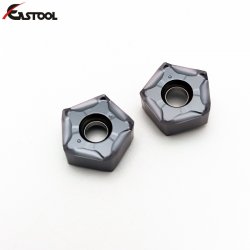Can Aluminum Milling Inserts Improve the Accuracy of Machined Parts

CNC cutting inserts are crucial components in machining operations and greatly impact the quality of the finished product. These inserts are used to cut, shape and form different materials with high precision and accuracy. They come in different shapes, sizes and materials to suit specific machining requirements.
The quality of the CNC cutting inserts determines the quality of the machining operation. Poor quality inserts can result in higher tool wear, poor surface finish, and decreased cutting speed. Conversely, high-quality cutting inserts can provide improved efficiency, superior surface finish and durability resulting in reduced production costs and increased productivity levels.
The quality of CNC cutting inserts is determined by its shape, material, and coating. The shape of the insert impacts its ability to withstand high cutting forces, flexibility and the range of operations it can perform efficiently. There are different shapes of cutting inserts such as square, triangular, round and diamond-shaped inserts. Each shape is designed to perform a specific task and optimized for specific materials and operations.
The material used to make the insert also plays a crucial role in determining its quality. The material must be hard enough to withstand high cutting forces, yet durable and resistant to high temperatures and chemical reactions that occur during the machining process. There are different materials used to make cutting inserts such as carbide, cermet, ceramic, and high-speed steel. Each material Milling Carbide Inserts has its own unique properties that make it suitable for specific types of machining operations. For instance, carbide is commonly used for cutting steel because of its superior strength and hardness.
Coating is another factor that impacts the quality of CNC cutting inserts. The coating provides the inserts with additional protection against wear, reduces friction and improves surface finish. There are different coatings that can be applied to a cutting insert, such as titanium nitride (TiN), titanium carbonitride (TiCN), and aluminum oxide (Al2O3). Each coating offers unique properties that make it suitable for specific applications. For example, TiN coating is often used for cutting aluminum because of its superior adhesion and Tungaloy Inserts resistance to oxidation.
In summary, CNC cutting inserts play a critical role in determining the quality of machining operations. Choosing the right shape, material, and coating can improve efficiency, reduce production costs, and improve the overall quality of the finished product. Therefore, it is essential to carefully consider these factors when selecting cutting inserts for specific machining operations and applications.




Ingen kommentarer endnu